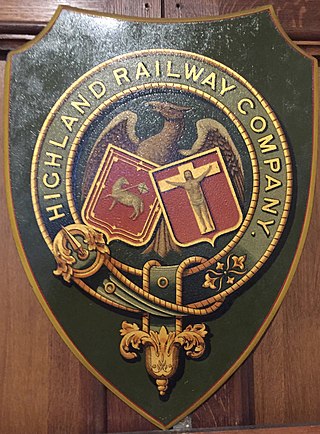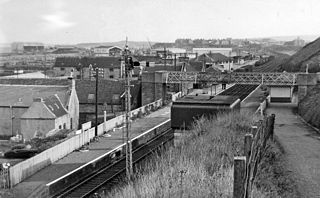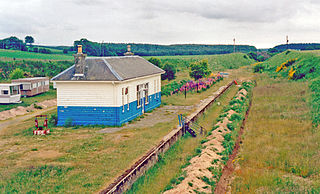
The Highland Railway (HR) was one of the smaller British railways before the Railways Act 1921, operating north of Perth railway station in Scotland and serving the farthest north of Britain. Based in Inverness, the company was formed by merger in 1865, absorbing over 249 miles (401 km) of line. It continued to expand, reaching Wick and Thurso in the north and Kyle of Lochalsh in the west, eventually serving the counties of Caithness, Sutherland, Ross & Cromarty, Inverness, Perth, Nairn, Moray and Banff. Southward it connected with the Caledonian Railway at Stanley Junction, north of Perth, and eastward with the Great North of Scotland Railway at Boat of Garten, Elgin, Keith and Portessie.

Drybridge railway station was a railway station serving the village of Drybridge, North Ayrshire, Scotland.
The Buckie and Portessie Branch was a railway branch line in Scotland, built by the Highland Railway to serve an important fishing harbour at Buckie, in Banffshire. It connected with the rival Great North of Scotland Railway at Portessie.

Portessie railway station was a joint Highland Railway (HR) and Great North of Scotland Railway (GNoSR) station at the junction between the Moray Coast Railway and the Buckie and Portessie Branch which also served the small fishing village of Portessie, in the parish of Rathven, Scottish county of Moray.

Buckie railway station was a railway station in Buckie, in current day Moray. The station was opened by the Great North of Scotland Railway (GNoSR) on its Moray Firth coast line in 1886, served by Aberdeen to Elgin trains.

Buckpool railway station was a railway station in Buckpool near Buckie in Moray. The railway station was opened by the Great North of Scotland Railway (GNoSR) on its Moray Firth coast line in 1886, served by Aberdeen to Elgin trains. The village and station were originally named Nether Buckie station and the station was renamed 'Buckpool' on 1 January 1887, closing to regular passenger traffic on 7 March 1960, several years before the closure of the line itself in 1968.

Portgordon railway station was a railway station in Portgordon in Moray, Scotland. The railway station was opened by the Great North of Scotland Railway (GNoSR) on its Moray Firth coast line in 1886, served by Aberdeen to Elgin trains. In 1923 the GNoSR became part of the London and North Eastern Railway (LNER) and at nationalisation in 1948 became part of British Railways. The station was named Port Gordon railway station until 1938 when it was renamed 'Portgordon' by the LNER.

Spey Bay railway station was a railway station in Spey Bay, Moray. The railway station was opened by the Great North of Scotland Railway (GNoSR) on its Moray Firth coast line in 1886, served by Aberdeen to Elgin trains. The station was originally named Fochabers-on-Spey railway station on 1 May 1886. In November 1893 it became Fochabers railway station, Fochabers and Spey Bay railway station on 1 January 1916 before finally becoming on 1 January 1918 Spey Bay railway station. It closed to regular passenger traffic on 6 May 1968 on the same date as the line itself.

Garmouth railway station was a railway station in Garmouth, parish of Urquhart, Moray. The railway station was opened by the Great North of Scotland Railway (GNoSR) on its Moray Firth coast line in 1884, served by Aberdeen to Elgin trains. It served the villages of Kingston-on-Spey and Garmouth and closed to regular passenger traffic on 6 May 1968 on the same date as the line itself.

Urquhart railway station was a railway station serving the village of Urquhart, parish of Urquhart, Moray. The railway station was opened by the Great North of Scotland Railway (GNoSR) on its Moray Firth coast line in 1884, served by Aberdeen to Elgin trains.
Calcots railway station was a railway station in the parish of St Andrews-Lhanbryd, Moray. The railway station was opened by the Great North of Scotland Railway (GNoSR) on its Moray Firth coast line in 1884, served by Aberdeen to Elgin trains. It served a rural area rather than a discrete settlement and closed to regular passenger traffic on 6 May 1968 on the same date as the line itself.

Enzie railway station was a station which served the hamlet of Enzie, in the Scottish county of Moray. It was served by trains on the Buckie and Portessie Branch north of Keith. The latter station is now the nearest to Enzie.
Rathven railway station was a station which served the hamlet of that name, about a mile away in the parish of Rathven, Scottish county of Moray. It was served by trains on the Buckie and Portessie Branch north of Keith.

Buckie railway station was one of two stations which once served the town of Buckie, in the parish of Rathven, Scottish county of Moray. This Highland Railway station was served by trains on the Buckie and Portessie Branch north of Keith until 1915 and remained open for freight until April 1944.
Findochty railway station was a railway station in the small fishing village of Findochty, Moray about 3 miles to the east of Buckie. The railway station was opened by the Great North of Scotland Railway (GNoSR) on its Moray Firth coast line in 1886, served by Aberdeen to Elgin trains.
Portknockie railway station was a railway station that served the small fishing village of Portknockie, close to Cullen in Moray. The railway station was opened by the Great North of Scotland Railway (GNoSR) on its Moray Firth coast line in 1886, served by Aberdeen to Elgin trains.

Cullen railway station was a railway station that served the small fishing village of Cullen, close to Portknockie in Moray. The railway station was opened by the Great North of Scotland Railway (GNoSR) on its Moray Firth coast line in 1886, served by Aberdeen to Elgin trains.
Tochieneal railway station was a railway station that served the small industrial village of Tochieneal, close to Cullen in Moray. The railway station was opened by the Great North of Scotland Railway (GNoSR) on its Moray Firth coast line in 1884. The station closed to regular passenger traffic on 1 October 1951, more than a decade before the total closure of the line itself in 1968.

Glassaugh railway station was a railway station that served the rural area of Glassaugh and the nearby Glenglassaugh distillery close to Portsoy in Moray. The railway station was opened by the Great North of Scotland Railway (GNoSR) on its Moray Firth coast line in 1884, served by Aberdeen to Elgin trains. The station closed to regular passenger traffic on 21 September 1953, more than a decade before the total closure of the line itself in 1968.

Millegin railway station, Millagan railway station or later Millegin Siding was briefly an intermediate stop situated on what became the Great North of Scotland Railway (GNoSR) line from Grange and Cairnie Junction to Tillynaught. Millegin served the rural community and the nearby saw mill in Banffshire. The line northwards ran to Tillynaught where it split to reach Banff by a branch line or Elgin by the Moray Coast line.















